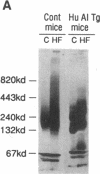Abstract
In humans, diets high in saturated fat and cholesterol raise HDL-cholesterol (HDL-C) levels. To explore the mechanism, we have devised a mouse model that mimics the human situation. In this model, HuAITg and control mice were studied on low fat (9% cal)-low cholesterol (57 mg/1,000 kcal) (chow) and high fat (41% cal)-high cholesterol (437 mg/1,000 kcal) (milk-fat based) diets. The mice responded to increased dietary fat by increasing both HDL-C and apo A-I levels, with a greater increase in HDL-C levels. This was compatible with an increase in HDL size observed by nondenaturing gradient gel electrophoresis. Turnover studies with doubly labeled HDL showed that dietary fat both increase the transport rate (TR) and decreased the fractional catabolic rate of HDL cholesterol ester (CE) and apo A-I, with the largest effect on HDL CE TR. The latter suggested that dietary fat increases reverse cholesterol transport through the HDL pathway, perhaps as an adaptation to the metabolic load of a high fat diet. The increase in apo A-I TR by dietary fat was confirmed by experiments showing increased apo A-I secretion from primary hepatocytes isolated from animals on the high fat diet. The increased apo A-I production was not associated with any increase in hepatic or intestinal apo A-I mRNA, suggesting that the mechanism of the dietary fat effect was posttranscriptional, involving either increased translatability of the apo A-I mRNA or less intracellular apo A-I degradation. The dietary fat-induced decrease in HDL CE and apo A-I fractional catabolic rate may have been caused by the increase in HDL particle size, as was suggested by our previous studies in humans. In summary, a mouse model has been developed and experiments performed to better understand the paradoxical HDL-raising effect of a high fat diet.
Full text
PDF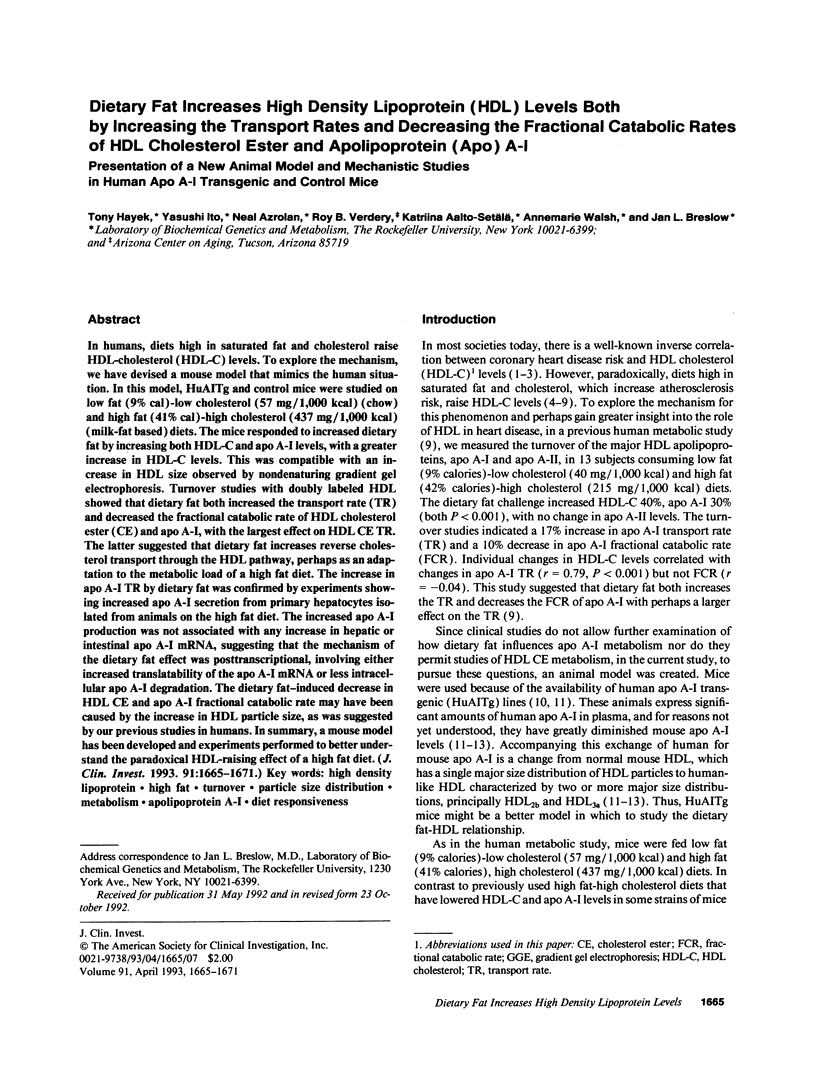
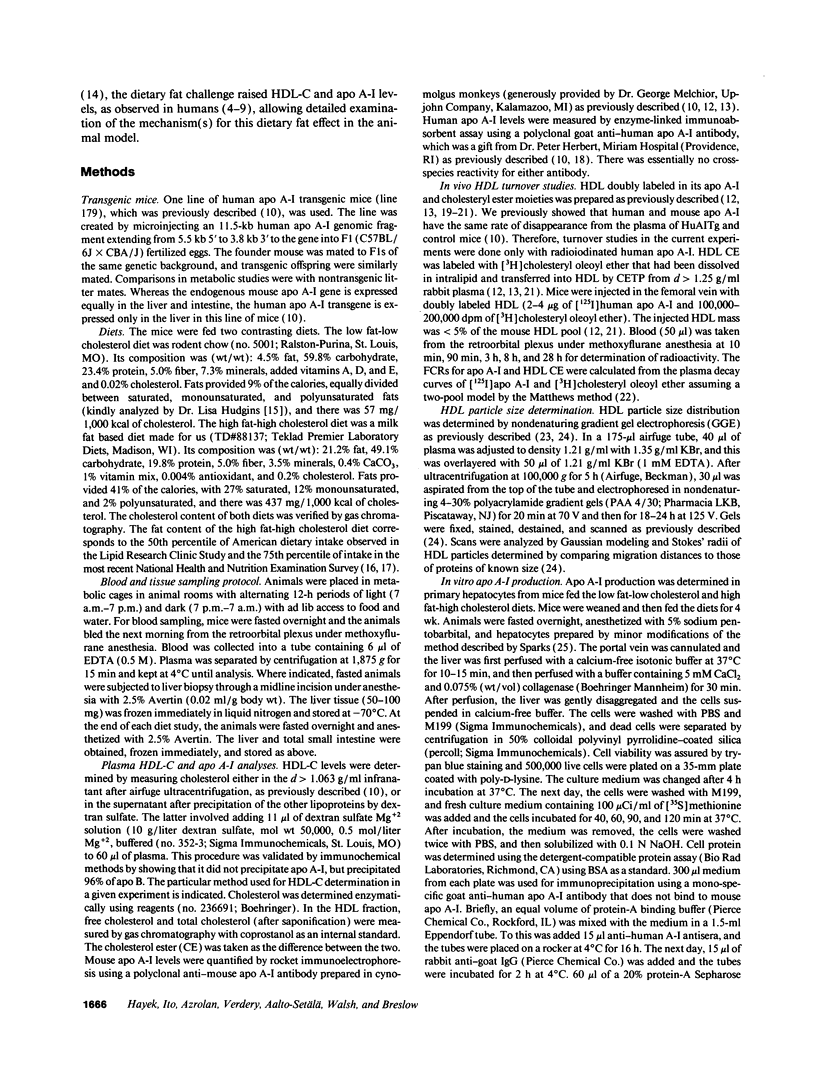
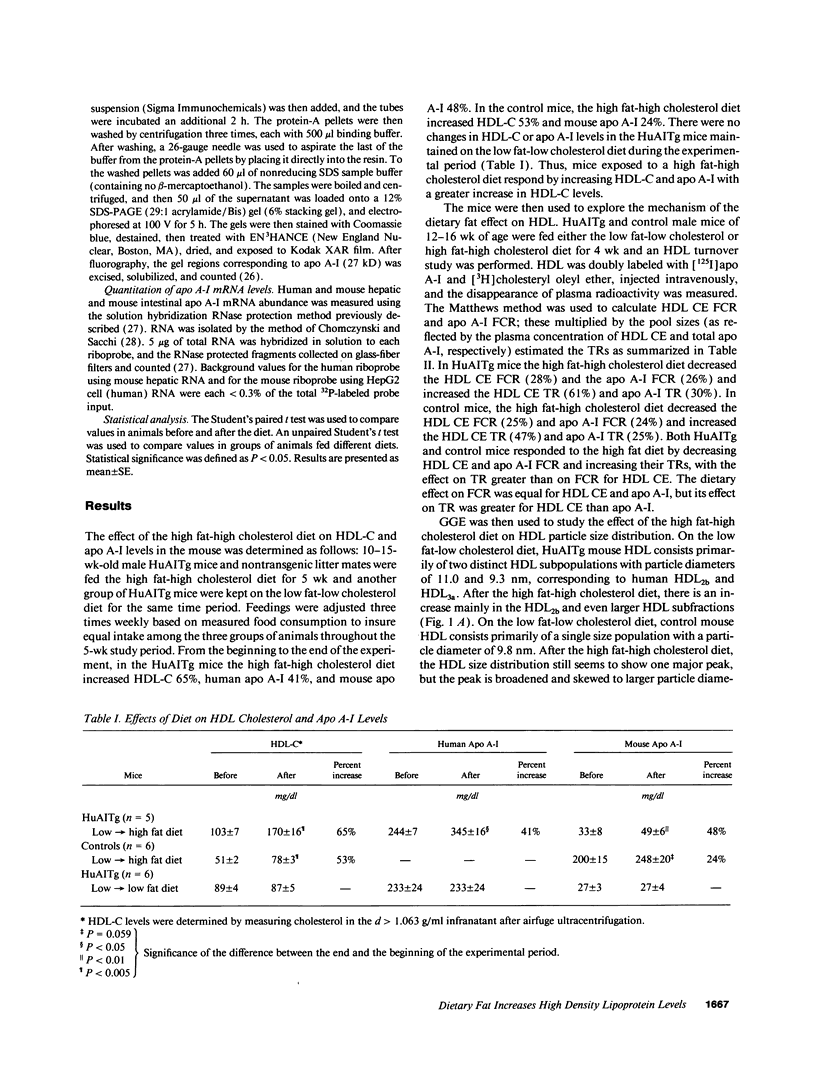
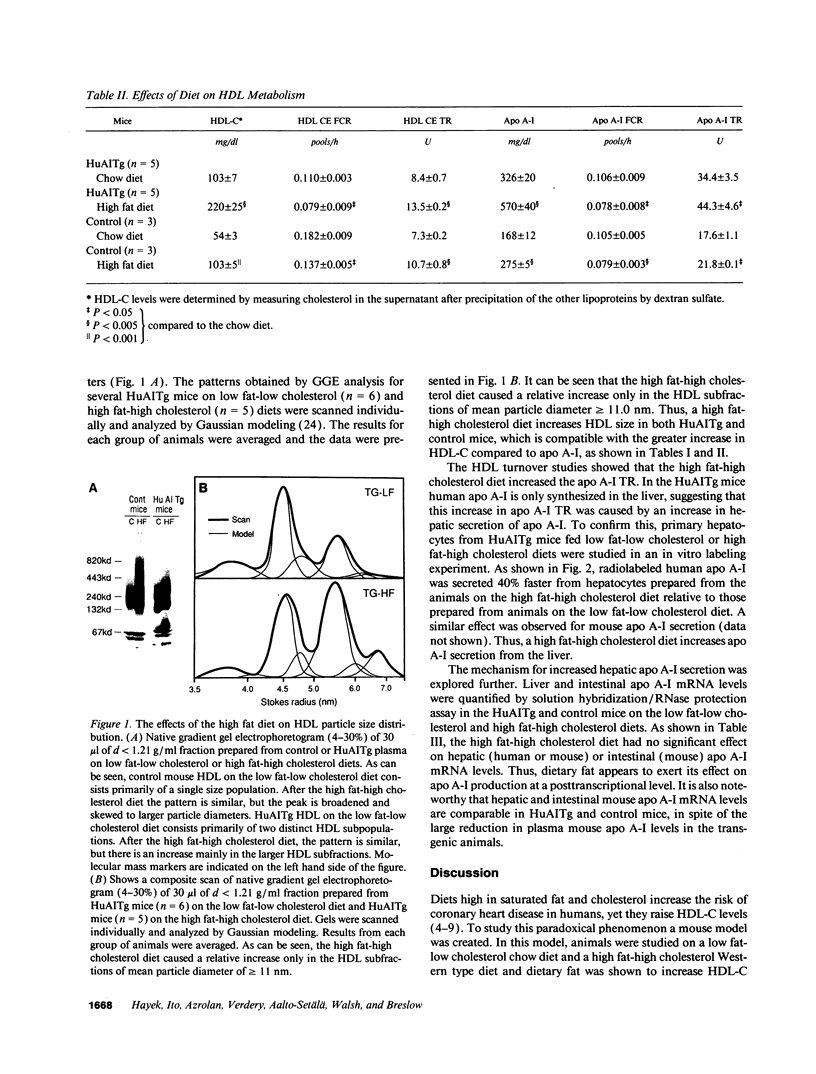
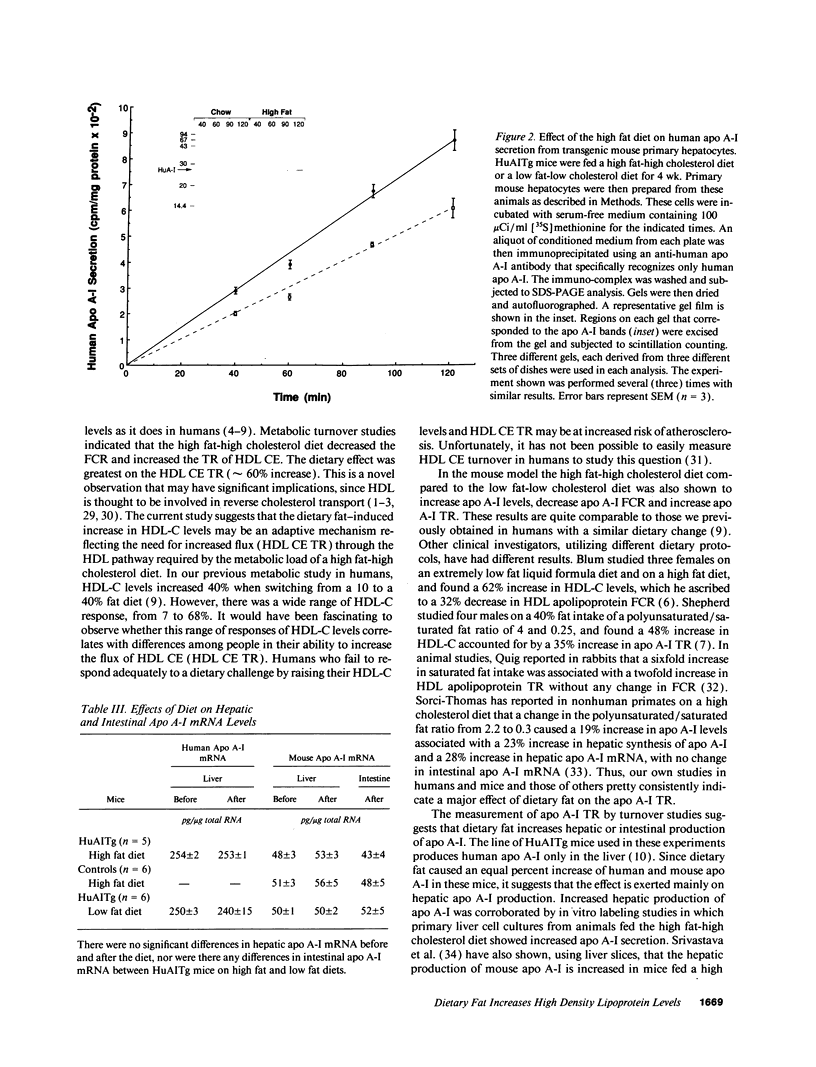
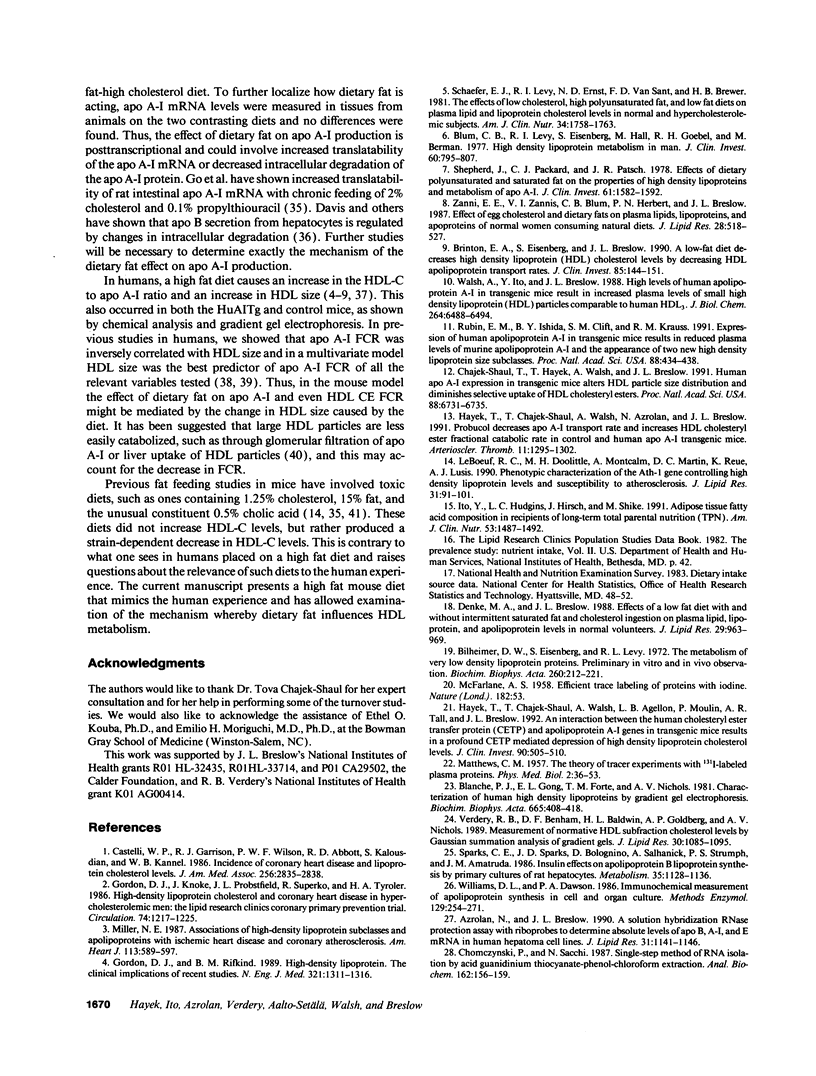
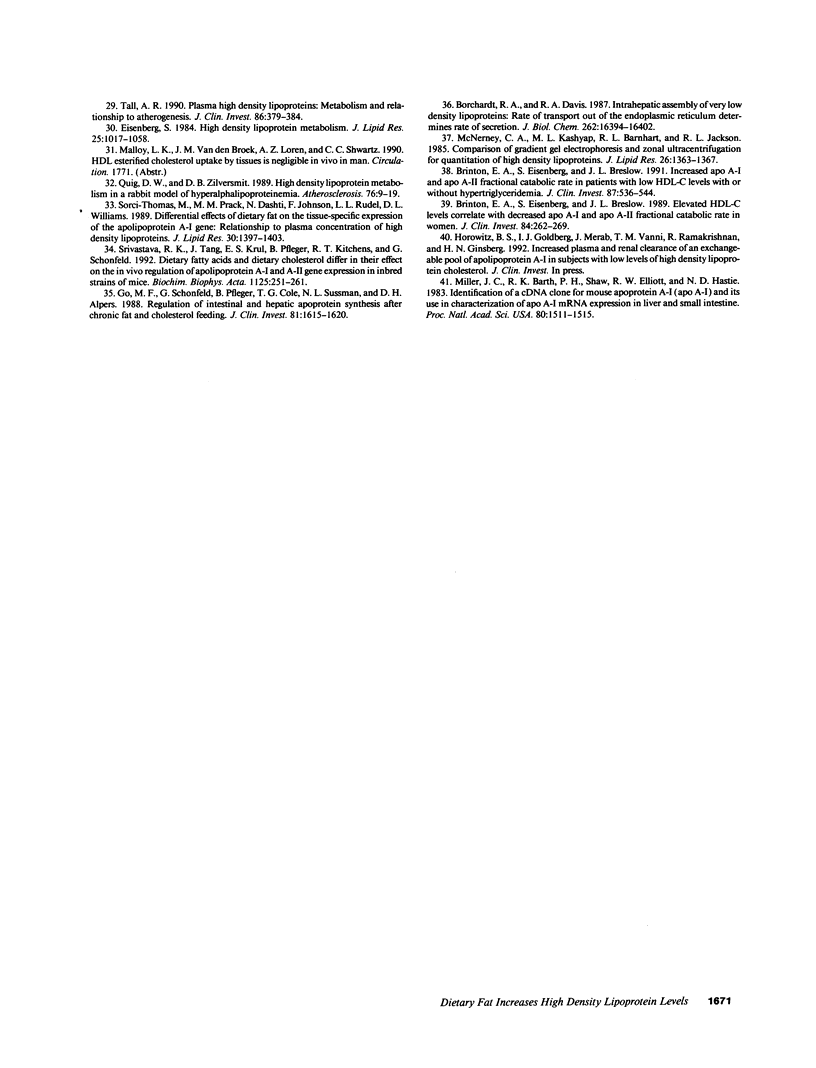
Images in this article
Selected References
These references are in PubMed. This may not be the complete list of references from this article.
- Azrolan N., Breslow J. L. A solution hybridization/RNase protection assay with riboprobes to determine absolute levels of apoB, A-I, and E mRNA in human hepatoma cell lines. J Lipid Res. 1990 Jun;31(6):1141–1146. [PubMed] [Google Scholar]
- Bilheimer D. W., Eisenberg S., Levy R. I. The metabolism of very low density lipoprotein proteins. I. Preliminary in vitro and in vivo observations. Biochim Biophys Acta. 1972 Feb 21;260(2):212–221. doi: 10.1016/0005-2760(72)90034-3. [DOI] [PubMed] [Google Scholar]
- Blanche P. J., Gong E. L., Forte T. M., Nichols A. V. Characterization of human high-density lipoproteins by gradient gel electrophoresis. Biochim Biophys Acta. 1981 Sep 24;665(3):408–419. doi: 10.1016/0005-2760(81)90253-8. [DOI] [PubMed] [Google Scholar]
- Blum C. B., Levy R. I., Eisenberg S., Hall M., 3rd, Goebel R. H., Berman M. High density lipoprotein metabolism in man. J Clin Invest. 1977 Oct;60(4):795–807. doi: 10.1172/JCI108833. [DOI] [PMC free article] [PubMed] [Google Scholar]
- Borchardt R. A., Davis R. A. Intrahepatic assembly of very low density lipoproteins. Rate of transport out of the endoplasmic reticulum determines rate of secretion. J Biol Chem. 1987 Dec 5;262(34):16394–16402. [PubMed] [Google Scholar]
- Brinton E. A., Eisenberg S., Breslow J. L. A low-fat diet decreases high density lipoprotein (HDL) cholesterol levels by decreasing HDL apolipoprotein transport rates. J Clin Invest. 1990 Jan;85(1):144–151. doi: 10.1172/JCI114405. [DOI] [PMC free article] [PubMed] [Google Scholar]
- Brinton E. A., Eisenberg S., Breslow J. L. Elevated high density lipoprotein cholesterol levels correlate with decreased apolipoprotein A-I and A-II fractional catabolic rate in women. J Clin Invest. 1989 Jul;84(1):262–269. doi: 10.1172/JCI114149. [DOI] [PMC free article] [PubMed] [Google Scholar]
- Brinton E. A., Eisenberg S., Breslow J. L. Increased apo A-I and apo A-II fractional catabolic rate in patients with low high density lipoprotein-cholesterol levels with or without hypertriglyceridemia. J Clin Invest. 1991 Feb;87(2):536–544. doi: 10.1172/JCI115028. [DOI] [PMC free article] [PubMed] [Google Scholar]
- Castelli W. P., Garrison R. J., Wilson P. W., Abbott R. D., Kalousdian S., Kannel W. B. Incidence of coronary heart disease and lipoprotein cholesterol levels. The Framingham Study. JAMA. 1986 Nov 28;256(20):2835–2838. [PubMed] [Google Scholar]
- Chajek-Shaul T., Hayek T., Walsh A., Breslow J. L. Expression of the human apolipoprotein A-I gene in transgenic mice alters high density lipoprotein (HDL) particle size distribution and diminishes selective uptake of HDL cholesteryl esters. Proc Natl Acad Sci U S A. 1991 Aug 1;88(15):6731–6735. doi: 10.1073/pnas.88.15.6731. [DOI] [PMC free article] [PubMed] [Google Scholar]
- Chomczynski P., Sacchi N. Single-step method of RNA isolation by acid guanidinium thiocyanate-phenol-chloroform extraction. Anal Biochem. 1987 Apr;162(1):156–159. doi: 10.1006/abio.1987.9999. [DOI] [PubMed] [Google Scholar]
- Denke M. A., Breslow J. L. Effects of a low fat diet with and without intermittent saturated fat and cholesterol ingestion on plasma lipid, lipoprotein, and apolipoprotein levels in normal volunteers. J Lipid Res. 1988 Jul;29(7):963–969. [PubMed] [Google Scholar]
- Eisenberg S. High density lipoprotein metabolism. J Lipid Res. 1984 Oct;25(10):1017–1058. [PubMed] [Google Scholar]
- Go M. F., Schonfeld G., Pfleger B., Cole T. G., Sussman N. L., Alpers D. H. Regulation of intestinal and hepatic apoprotein synthesis after chronic fat and cholesterol feeding. J Clin Invest. 1988 May;81(5):1615–1620. doi: 10.1172/JCI113496. [DOI] [PMC free article] [PubMed] [Google Scholar]
- Gordon D. J., Knoke J., Probstfield J. L., Superko R., Tyroler H. A. High-density lipoprotein cholesterol and coronary heart disease in hypercholesterolemic men: the Lipid Research Clinics Coronary Primary Prevention Trial. Circulation. 1986 Dec;74(6):1217–1225. doi: 10.1161/01.cir.74.6.1217. [DOI] [PubMed] [Google Scholar]
- Gordon D. J., Rifkind B. M. High-density lipoprotein--the clinical implications of recent studies. N Engl J Med. 1989 Nov 9;321(19):1311–1316. doi: 10.1056/NEJM198911093211907. [DOI] [PubMed] [Google Scholar]
- Hayek T., Chajek-Shaul T., Walsh A., Agellon L. B., Moulin P., Tall A. R., Breslow J. L. An interaction between the human cholesteryl ester transfer protein (CETP) and apolipoprotein A-I genes in transgenic mice results in a profound CETP-mediated depression of high density lipoprotein cholesterol levels. J Clin Invest. 1992 Aug;90(2):505–510. doi: 10.1172/JCI115887. [DOI] [PMC free article] [PubMed] [Google Scholar]
- Hayek T., Chajek-Shaul T., Walsh A., Azrolan N., Breslow J. L. Probucol decreases apolipoprotein A-I transport rate and increases high density lipoprotein cholesteryl ester fractional catabolic rate in control and human apolipoprotein A-I transgenic mice. Arterioscler Thromb. 1991 Sep-Oct;11(5):1295–1302. doi: 10.1161/01.atv.11.5.1295. [DOI] [PubMed] [Google Scholar]
- Ito Y., Hudgins L. C., Hirsch J., Shike M. Adipose-tissue fatty acid composition in recipients of long-term total parenteral nutrition (TPN). Am J Clin Nutr. 1991 Jun;53(6):1487–1492. doi: 10.1093/ajcn/53.6.1487. [DOI] [PubMed] [Google Scholar]
- LeBoeuf R. C., Doolittle M. H., Montcalm A., Martin D. C., Reue K., Lusis A. J. Phenotypic characterization of the Ath-1 gene controlling high density lipoprotein levels and susceptibility to atherosclerosis. J Lipid Res. 1990 Jan;31(1):91–101. [PubMed] [Google Scholar]
- MATTHEWS C. M. The theory of tracer experiments with 131I-labelled plasma proteins. Phys Med Biol. 1957 Jul;2(1):36–53. doi: 10.1088/0031-9155/2/1/305. [DOI] [PubMed] [Google Scholar]
- McNerney C. A., Kashyap M. L., Barnhart R. L., Jackson R. L. Comparison of gradient gel electrophoresis and zonal ultracentrifugation for quantitation of high density lipoproteins. J Lipid Res. 1985 Nov;26(11):1363–1367. [PubMed] [Google Scholar]
- Miller J. C., Barth R. K., Shaw P. H., Elliott R. W., Hastie N. D. Identification of a cDNA clone for mouse apoprotein A-1 (apo A-1) and its use in characterization of apo A-1 mRNA expression in liver and small intestine. Proc Natl Acad Sci U S A. 1983 Mar;80(6):1511–1515. doi: 10.1073/pnas.80.6.1511. [DOI] [PMC free article] [PubMed] [Google Scholar]
- Miller N. E. Associations of high-density lipoprotein subclasses and apolipoproteins with ischemic heart disease and coronary atherosclerosis. Am Heart J. 1987 Feb;113(2 Pt 2):589–597. doi: 10.1016/0002-8703(87)90638-7. [DOI] [PubMed] [Google Scholar]
- Quig D. W., Zilversmit D. B. High density lipoprotein metabolism in a rabbit model of hyperalphalipoproteinemia. Atherosclerosis. 1989 Mar;76(1):9–19. doi: 10.1016/0021-9150(89)90189-5. [DOI] [PubMed] [Google Scholar]
- Rubin E. M., Ishida B. Y., Clift S. M., Krauss R. M. Expression of human apolipoprotein A-I in transgenic mice results in reduced plasma levels of murine apolipoprotein A-I and the appearance of two new high density lipoprotein size subclasses. Proc Natl Acad Sci U S A. 1991 Jan 15;88(2):434–438. doi: 10.1073/pnas.88.2.434. [DOI] [PMC free article] [PubMed] [Google Scholar]
- Schaefer E. J., Levy R. I., Ernst N. D., Van Sant F. D., Brewer H. B., Jr The effects of low cholesterol, high polyunsaturated fat, and low fat diets on plasma lipid and lipoprotein cholesterol levels in normal and hypercholesterolemic subjects. Am J Clin Nutr. 1981 Sep;34(9):1758–1763. doi: 10.1093/ajcn/34.9.1758. [DOI] [PubMed] [Google Scholar]
- Shepherd J., Packard C. J., Patsch J. R., Gotto A. M., Jr, Taunton O. D. Effects of dietary polyunsaturated and saturated fat on the properties of high density lipoproteins and the metabolism of apolipoprotein A-I. J Clin Invest. 1978 Jun;61(6):1582–1592. doi: 10.1172/JCI109078. [DOI] [PMC free article] [PubMed] [Google Scholar]
- Sorci-Thomas M., Prack M. M., Dashti N., Johnson F., Rudel L. L., Williams D. L. Differential effects of dietary fat on the tissue-specific expression of the apolipoprotein A-I gene: relationship to plasma concentration of high density lipoproteins. J Lipid Res. 1989 Sep;30(9):1397–1403. [PubMed] [Google Scholar]
- Sparks C. E., Sparks J. D., Bolognino M., Salhanick A., Strumph P. S., Amatruda J. M. Insulin effects on apolipoprotein B lipoprotein synthesis and secretion by primary cultures of rat hepatocytes. Metabolism. 1986 Dec;35(12):1128–1136. doi: 10.1016/0026-0495(86)90026-0. [DOI] [PubMed] [Google Scholar]
- Srivastava R. A., Tang J., Krul E. S., Pfleger B., Kitchens R. T., Schonfeld G. Dietary fatty acids and dietary cholesterol differ in their effect on the in vivo regulation of apolipoprotein A-I and A-II gene expression in inbred strains of mice. Biochim Biophys Acta. 1992 May 8;1125(3):251–261. doi: 10.1016/0005-2760(92)90053-x. [DOI] [PubMed] [Google Scholar]
- Tall A. R. Plasma high density lipoproteins. Metabolism and relationship to atherogenesis. J Clin Invest. 1990 Aug;86(2):379–384. doi: 10.1172/JCI114722. [DOI] [PMC free article] [PubMed] [Google Scholar]
- Verdery R. B., Benham D. F., Baldwin H. L., Goldberg A. P., Nichols A. V. Measurement of normative HDL subfraction cholesterol levels by Gaussian summation analysis of gradient gels. J Lipid Res. 1989 Jul;30(7):1085–1095. [PubMed] [Google Scholar]
- Walsh A., Ito Y., Breslow J. L. High levels of human apolipoprotein A-I in transgenic mice result in increased plasma levels of small high density lipoprotein (HDL) particles comparable to human HDL3. J Biol Chem. 1989 Apr 15;264(11):6488–6494. [PubMed] [Google Scholar]
- Williams D. L., Dawson P. A. Immunochemical measurement of apolipoprotein synthesis in cell and organ culture. Methods Enzymol. 1986;129:254–271. doi: 10.1016/0076-6879(86)29074-6. [DOI] [PubMed] [Google Scholar]
- Zanni E. E., Zannis V. I., Blum C. B., Herbert P. N., Breslow J. L. Effect of egg cholesterol and dietary fats on plasma lipids, lipoproteins, and apoproteins of normal women consuming natural diets. J Lipid Res. 1987 May;28(5):518–527. [PubMed] [Google Scholar]



